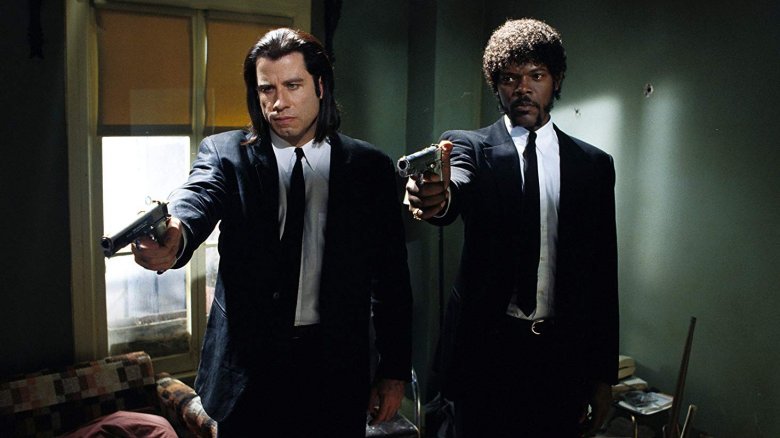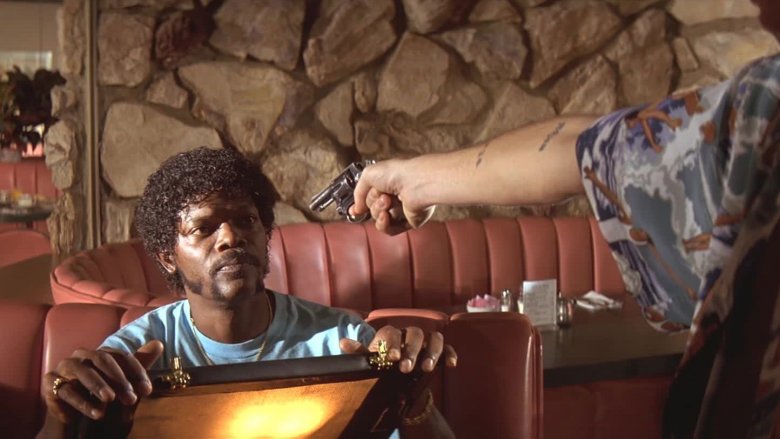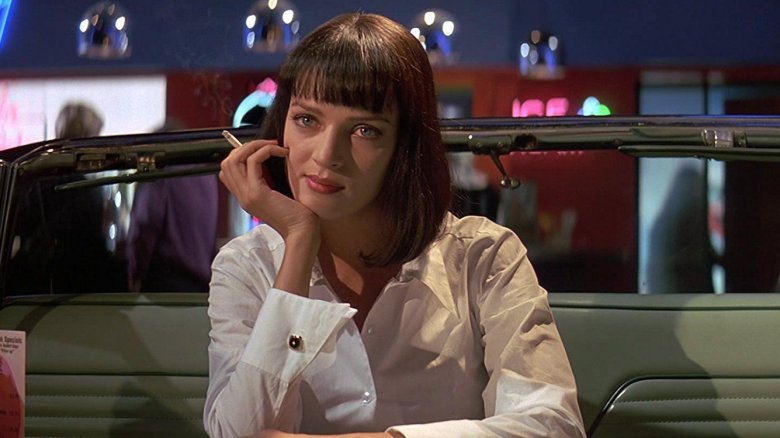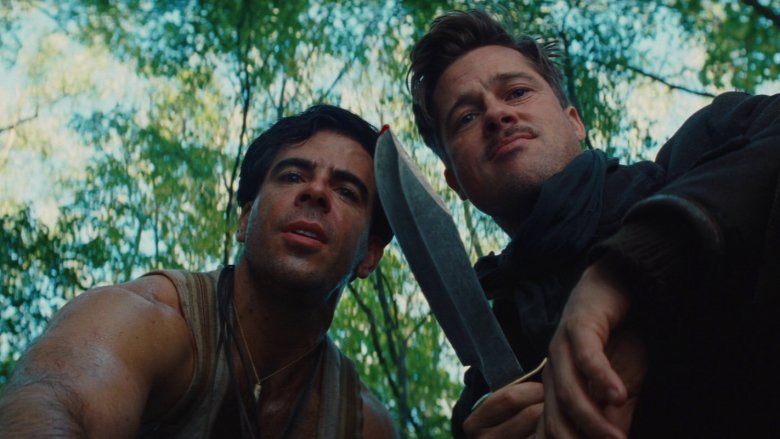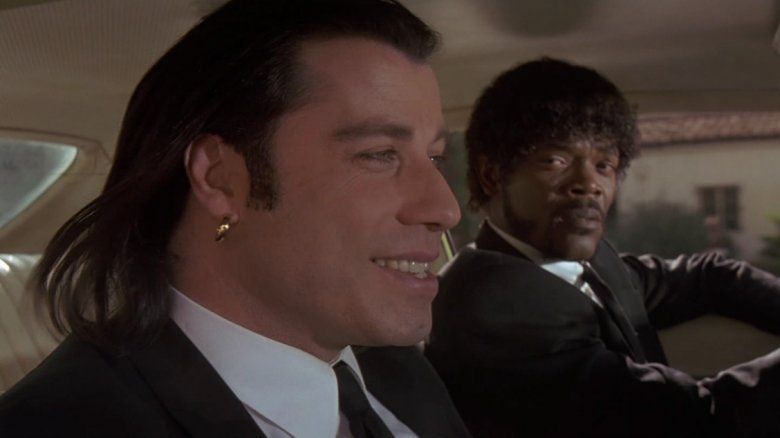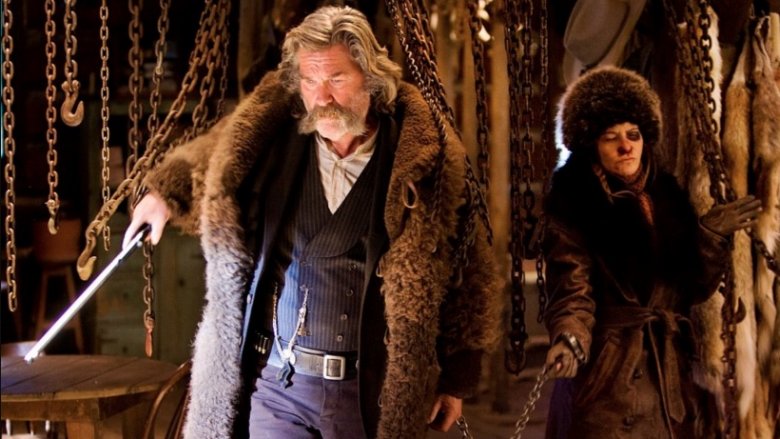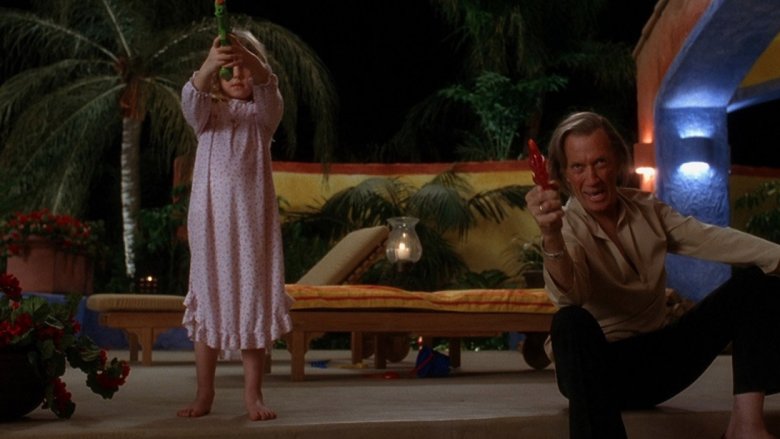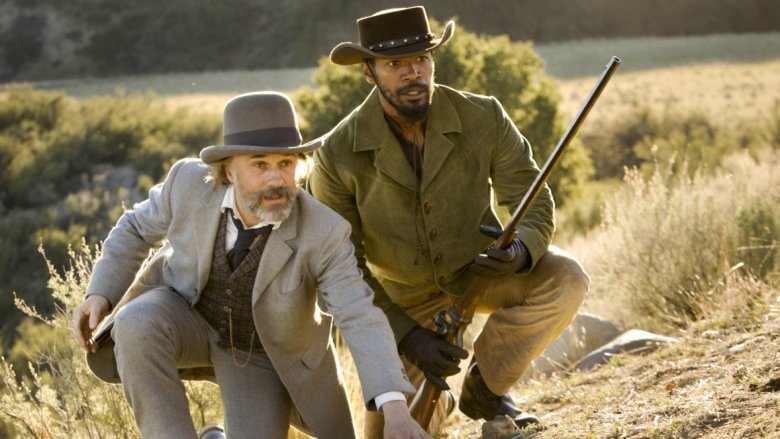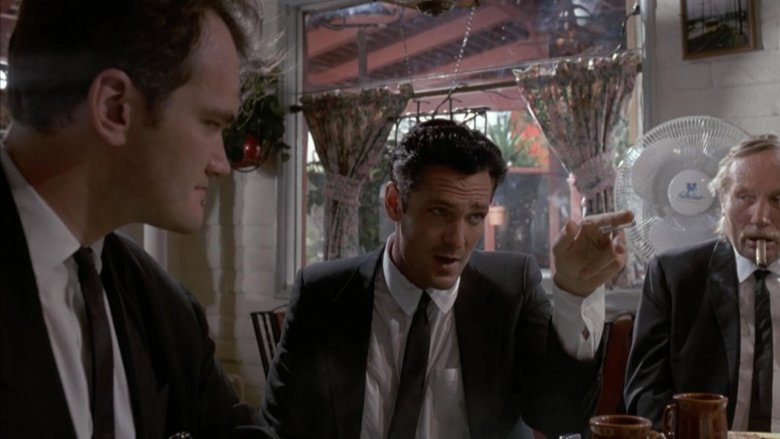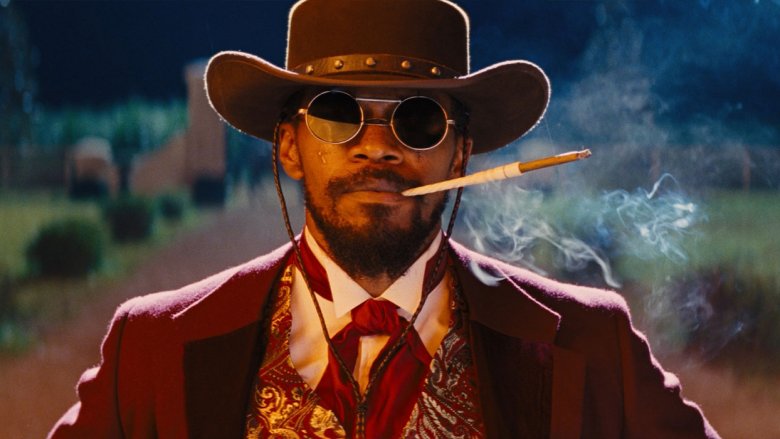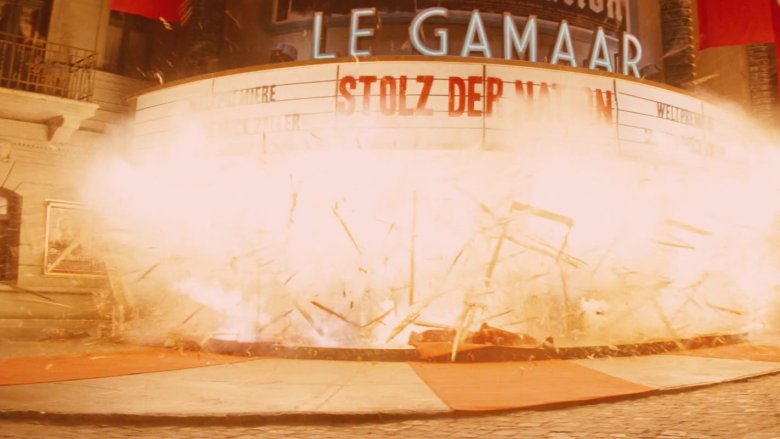Tarantino Movie Fan Theories That Could Actually Be True
Quentin Tarantino: love him or hate him, he's undeniably one of the most well-known directors in Hollywood today, a provocative auteur who's able to turn original concepts into legitimate mainstream successes (although how original those scripts and concepts are is somewhat up for debate). He's an undeniable talent at coaxing phenomenal performances out of actors whose better days seemed behind them.
In just eight directorial efforts (and a ninth on the horizon in Once Upon a Time in Hollywood) and a handful of scripts, Tarantino has earned himself a coveted place in fans' hearts. In the years since Reservoir Dogs was released in 1992, fans have flocked to his films to draw connections between different movies' plots and themes, guess at the writer-director's scrapped plans, and imagine a full shared universe of his films. In short, for a guy who's always been pretty into comic books, his films have enough fan theories that even the filmmakers behind the Marvel Cinematic Universe might be a touch jealous. Here are some of the best fan theories about Tarantino's films that could very well be true.
The briefcase in Pulp Fiction holds Marsellus' soul
We'll start with arguably the best-known fan theory associated with Quentin Tarantino's career: the mystery of what exactly is in the briefcase that Jules (Samuel L. Jackson) and Vincent (John Travolta) get back for their boss Marsellus Wallace (Ving Rhames) in the beginning of Pulp Fiction. Viewers never see what's actually in the briefcase, but the awed faces on those who do, and the gentle orange glow that emanates from inside, have set fans' hearts aflutter for years. There's plenty of good guesses that range from diamonds to Elvis' gold suit to an irradiated isotope, in a reference to Kiss Me Deadly.
Ultimately, though, the most compelling fan theory is that the briefcase contains Wallace's soul, which he sold to the Devil to amass the underworld power that he holds in the film. The code to unlock the briefcase is "666" and an iconic shot over Marsellus' shoulder includes a conspicuous band-aid over the back of his neck. Proponents of the theory argue that the band-aid covers the wound where the Devil pulled out Marsellus' soul, and that the "holy mission" that Jules goes on to recover the briefcase is what ultimately leads to him becoming a shepherd for the righteous man. While it's certainly intriguing, Tarantino has clarified that there's no "official" explanation for what's in the briefcase, while his co-writer Roger Avery has slammed the supernatural readings of the film altogether. It might not ever get confirmed, but the idea of a briefcase filled with a man's soul is a bit more exciting than a briefcase with a single orange light bulb in it.
The Deadly Viper Assassination Squad in Kill Bill are the characters Mia mentions in Pulp Fiction
When Vincent and Mia (Uma Thurman) are out to dinner in Pulp Fiction, she tells him about a television pilot she was briefly involved in: "It was a show about a team of female secret agents called Fox Force Five." Mia goes on to describe the team, which seems to loosely correspond to the members of the Deadly Viper Assassination Squad in Kill Bill (with Sofie Fatale subbed in to round out the group in place of the male Bud). Mia's character in the pilot was supposed to be the deadliest woman in the world with a blade in her hand, and a lover of corny jokes. Both of those could easily be applied to Beatrix Kiddo in Kill Bill. Any battle involving a sword ends with her victory, and she doesn't seem to mind bad jokes.
The theory isn't a perfect fit, though. The "black girl" in Mia's pilot is said to be a demolitions expert, while Vernita Green's specialty in Kill Bill is implied to be knives; Sofie Fatale doesn't seem to solve her problems with sex the way the "French girl" does in Mia's pilot, and there's plenty of other mismatches that don't quite line up. However, there is a way that this works: Mia's telling Vincent about a pilot that wasn't picked up; the actual movie Kill Bill could exist in the world of Pulp Fiction as the dark and gritty reimagining of the original pilot with some details sanded down between cancelled project and finished movie.
The Tarantino movie universe and the movie-movie universe.
If you're scratching your head about how Kill Bill could be a movie within a movie within the world of Pulp Fiction, there's actually a fan theory that makes it all work. Even better, this one was actually confirmed by Tarantino himself. The fan theory posits that there are actually two universes that Tarantino works within. Many of his movies share references or character names with other movies, but they actually run along two distinct tracks: there's the heightened real-life movies like Pulp Fiction and Reservoir Dogs (both of which feature a major character with the last name "Vega") and then there's the absurd action stylings of Kill Bill or From Dusk Till Dawn. As Tarantino himself put it, "When the characters of Reservoir Dogs or Pulp Fiction, when they go to the movies, Kill Bill is what they go to see. From Dusk Till Dawn is what they see."
Once you know about this, you can easily break down which universe each Tarantino movie takes place in. Django Unchained features a criminal with the last name of Koons — the same last name that Christopher Walken's character in Pulp Fiction has. So, that means that Django Unchained, despite its explosive climax, still takes place in the "real" world of Tarantino films.
Reservoir Dogs and Pulp Fiction take place on the same day
Speaking of connections between Tarantino movies, we'd be remiss to not mention one of the cleanest fan theories around: the idea that Reservoir Dogs and Pulp Fiction take place on the same day. Like the best fan theories, it exists to solve a problem by using the actual text of the movies — in this case, the problem being just how Vincent and Jules are able to drive around Los Angeles with a car filled with blood, brains, and a clearly-dead body. Los Angeles tends to have a reputation as a town where no one pays attention to anything that isn't themselves, but you'd still expect cops to pull over a blood-splattered car long before they get to Jimmie's house.
Supposedly, the reason is that the cops in LA are a little busy dealing with the diamond robbery that leads to the events of Reservoir Dogs. As we mentioned earlier, the two films are connected by more than just a director and scene-stealing performances from Tim Roth — Vincent Vega in Pulp Fiction and Vic Vega in Reservoir Dogs have been confirmed by Tarantino to be brothers (and nearly the stars of their own movie). With that in mind, it's an easy jump to imagine that the police presence in Pulp Fiction is a result of Vic Vega's homicidal tendencies. After all, what says brotherly love in a Tarantino film more than accidentally helping your brother out of a jam through absurd violence?
The Hateful Eight is a loose remake of The Thing
Quentin Tarantino loves movies. His detractors might say that he loves them too much, to the point of just repurposing his favorite shots, but no one can say that QT doesn't have a deep knowledge of film history, especially when it comes to genre films. The Hateful Eight, the second of Tarantino's repurposed Westerns following the "Southern" Django Unchained, is a bit of a weird entry in his oeuvre. It's violent and dialogue-driven, sure, but it's also nihilistic and gruesome to watch, with an emphasis on molded flesh that would make John Carpenter squeamish.
Some fans think there's a reason for that — that The Hateful Eight is actually a horror movie, a loose reimagining of Carpenter's genre-classic The Thing. There are definitely some parallels: a group of disparate people trapped together in snowy isolation, the slow one-by-one murder of their group by an unknown party, and, of course, Kurt Russell. Those are just the larger overlaps — there are plenty of other references: a thing hiding beneath the floorboards, musical cues, and even (SPOILER ALERT) an ending in which two men briefly bond before their unavoidable death, still unsure if they can even trust one another. In fact, the only real surprise here seems to be that Tarantino managed to avoid the impulse to make one of the eight an actual shapeshifting monster.
Beatrix never killed Bill in Kill Bill
We can already see you shaking your head. How can Bill not get killed in Kill Bill? It's literally the title of both Kill Bill Vol. 1 and Kill Bill Vol. 2. Well, let's start with the basic facts; Beatrix Kiddo, the Bride, is on a mission of vengeance against her former team and her mentor/lover, Bill. In Kill Bill Vol. 1, Beatrix kills O-Ren Ishii (Lucy Liu) and Vernita Green (Vivica A. Fox), leaving Sofie Fatale (not on the Squad officially) maimed as a message for Bill that Beatrix is coming for him. But Kill Bill Vol. 2, surprisingly, doesn't actually feature a long kill list. Bud (Michael Madsen), Bill's brother, is killed by Elle Driver (Daryl Hannah) while Beatrix is on her way back for round 2. Elle herself is only blinded by Beatrix, her name given a question mark in the credits. So, if Bill is killed by Beatrix in Kill Bill Vol. 2, he's alone in the dubious honor.
Let's dig in more, though. When Beatrix finally finds Bill, he's playing with their infant daughter B.B., to Beatrix's surprise. B.B. turns to Beatrix, pretends to shoot her, and Beatrix falls down and plays dead. The fan theory goes that Beatrix isn't actually killing Bill later — they're conducting an elaborate game of pretend. Bill fakes his death and Beatrix fakes her killing of him to end the quest they're both on. The biggest argument against it is that it's not quite as satisfying to have a movie called Kill Bill end with an alive Bill, but it's possible.
Once a dentist, always a dentist
Little is known about King Schultz (Christoph Waltz), one of the major characters in Django Unchained. He mentions having a wife, that he's originally from Germany, and that he was a practicing dentist before he became a bounty hunter. However, where the text ends is where fan theories begin, and there's been plenty of fans eager to fill in the enigmatic character's backstory. Ultimately, though, the best fan theory around is the one that doesn't focus on obvious mysteries like why King left Germany or what happened to his wife. Real fans want to know why he switched from dentistry to bounty hunting.
Well, there's not really much of a leap between the two, at least in terms of what scourge King is fighting. As a dentist, Schultz would have advised patients to not eat candy or brittle in order to protect their teeth. As a bounty hunter, Schultz was on the hunt for the Brittle Brothers and eventually ended up killing Calvin Candie. In either occupation, he's on the hunt for the cause of cavities, either literal or metaphorical. Or it could just be a reference to Doc Holliday, the dentist gunfighter. Either or both is possible when it comes to Tarantino.
Tarantino characters are obsessed with pop culture because of Inglourious Basterds
One of the prevailing hallmarks of a Tarantino film is long, extremely specific conversations about the "true meaning" of different elements of pop culture. There's the Superman conversation in Kill Bill, the discussion about Madonna's "Like A Virgin" in Reservoir Dogs, and many more. The easy explanation for why these conversations take up so much cinematic real estate in his films is that Tarantino likes and thinks a lot about pop culture, so putting those thoughts into his movies is a convenient way to get it out there. It's a bit less convenient than a blog, but who are we to judge?
One fan theory suggests that the reason Tarantino's characters are so obsessed with pop culture to the point of distraction is that the end of Inglorious Basterds features Hitler dying in a movie theater. We've already gone into the (confirmed) theory that all Tarantino movies are connected, either in the "real" world or the movie world. If Hitler died in a movie theater along with nearly all the Nazi high command, and if one of the Basterds' sons became a film mogul, there's a good chance that the United States would be even more obsessed with pop culture than we already are. The only thing this fan theory is missing is whether the MPAA ratings board was killed as well.
Django Unchained is a Shaft prequel
This might be the rare case where the director didn't even wait for a movie's release to confirm a fan theory. In Django Unchained, Django (Jamie Foxx) ends the film having rescued his wife Brunhilde von Shaft (Kerry Washington), riding off into the sunset for further adventures. Since Django doesn't have a last name of his own, it's likely that their child would keep Brunhilde's last name, von Shaft, which could conceivably be shortened down to Shaft over the centuries. That's also the last name of the Blaxploitation hero John Shaft, whose effortless cool and fighting prowess is a direct match for Django's. It's an easy connection for fans to make, especially for any fans as well-versed in genre films as Tarantino.
Right before the film's release, Tarantino came right out and confirmed this theory himself at Comic-Con 2012, stating that he saw his own film as a prequel to the famous franchise. Next time, maybe Tarantino can give fans a little bit of time to connect the dots themselves before he goes and shows them the finished picture.
The ending of Inglorious Basterds is a reference to Gremlins
We've already talked about Tarantino's near-worship of some of his favorite films. While other directors are content to acknowledge their influences in interviews and press junkets, QT goes the extra mile and more or less borrows some of his favorite shots from classic and not-so-classic films. But while that habit can be at turns delightful and annoying to film buffs, that doesn't mean that every reference and recontextualized shot gets caught by fans.
In fact, one very blatant homage has more or less gone unnoticed for years: that the fiery movie house ending to Inglourious Basterds has a whole lot in common with the similarly explosive climax to Gremlins. SyFy has a detailed comparison of the two movies' scenes, and it's so convincing you'll never be able to watch either movie the same way again. But it's not necessarily surprising that Tarantino would find himself influenced by Joe Dante's twisted cult masterpiece — anyone who's actually seen Gremlins knows that its Furby-like imagery hides a surprisingly violent and dark storyline. Why wouldn't QT be a fan?
